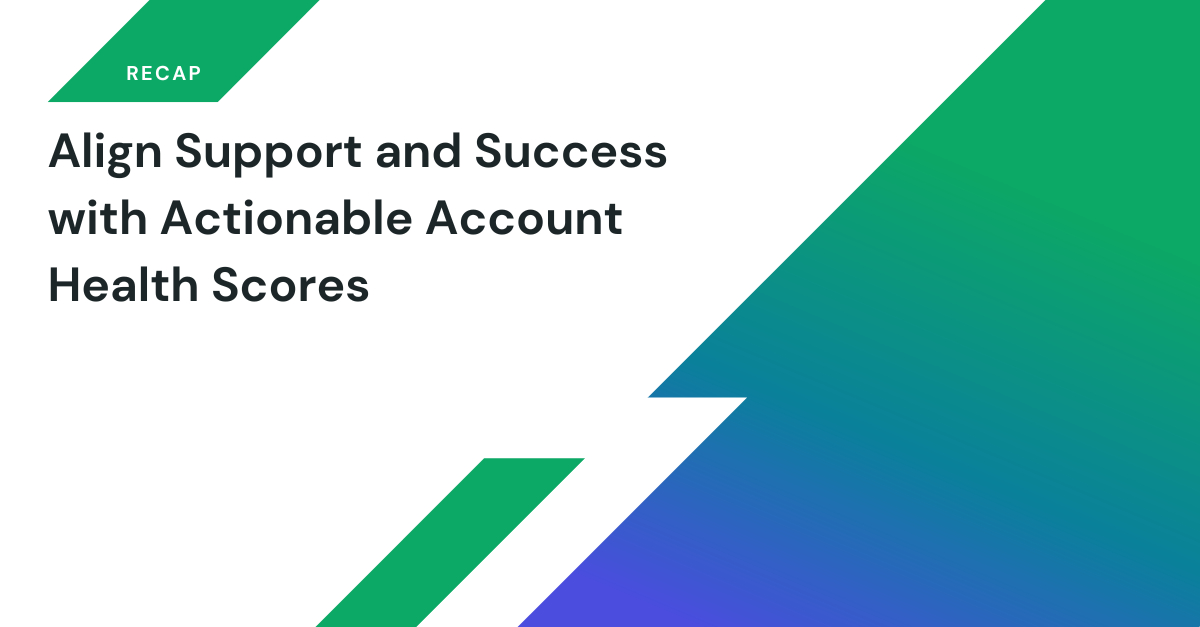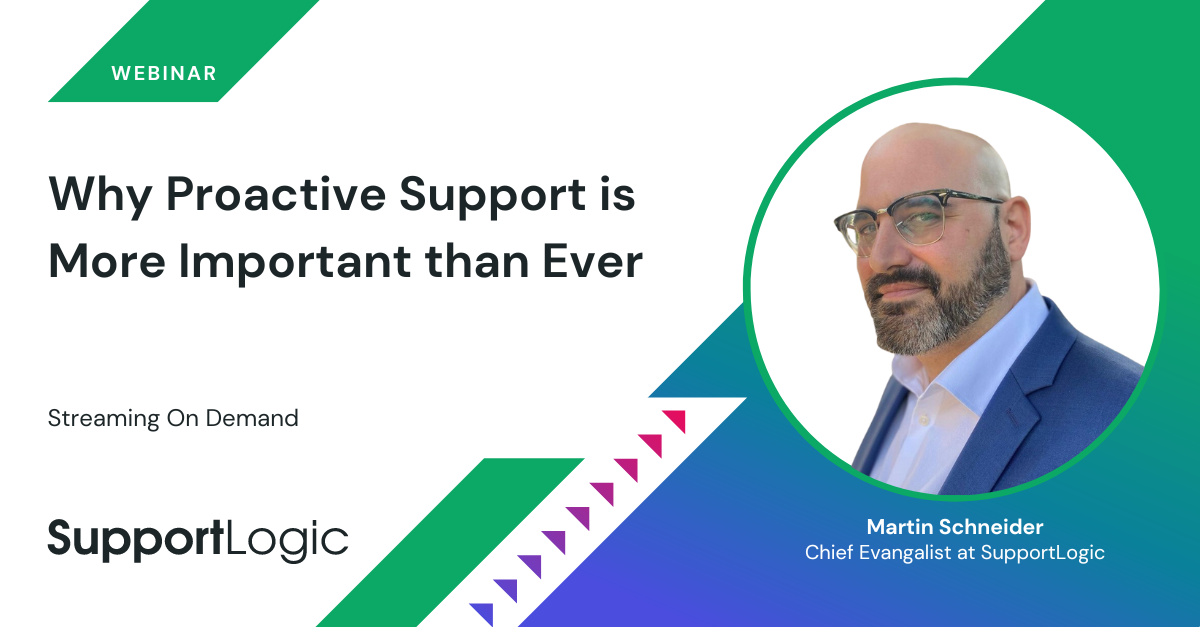
Dec 20, 2022
5 Questions with Judith Platz and John Ragsdale about How to Align Support and Success
Support Experienceproactive supportChurn Reductionbuild vs. buydigital transformationpredict escalations
Last week, we held a webinar with TSIA and had a great conversation and fun reunion between John Ragsdale, Distinguished VP, Technology Ecosystems, TSIA, and Judith Platz, Chief Customer Officer, SupportLogic, and former Vice President, Research Customer Success & Support at TSIA. John and Judi covered a number of topics around aligning customer support and success teams using actionable account health scores. Here’s a summary of key topics. You may also see the complete on-demand webinar and highlights here.

John: What is the most challenging aspect of Support today?
Judi: Support really went through so much during the COVID years and made so many amazing advancements. I’m still so proud of this industry and for every leader and employee who did what they did during COVID.
I fear that we’re taking steps backwards now. We all know the economic forecast isn’t that great. But I’m watching these momentous cost cutting exercises that are happening, where we’re losing some of our most beautifully skilled individuals. And we’re also not doubling down on the tooling that could help us when we’re doing so much more with less. I just don’t want to see support do that.
I think that there are ways to balance, for instance, investing in the tools to make the agent’s life better to make it easier to make the customer’s life better. While companies need to make short term and long term tradeoffs, let’s get some of the long term investment with gains going back on again. I think support over the years has just accepted that when there are reductions, it’ll start in support. I think we need to be better prepared to have the harder conversations with our CFO or CEO, etc. Because turning customer facing individuals away right now is probably really not the place to start.
John: There’s so much discussion about convergence between success and support. Is this something you’re seeing actually happen?
Judi: I think it’s been talked about for quite a while as people continue to figure out what customer success does. I think people are still struggling with the charter of customer success. e.g. Is it owning the renewal? Is it owning the expansion? Is it being tactical or strategic?
So I think there’s still a lot of fleshing out that needs to happen, while more mature companies have it down to an art and a science. I do think the functions are converging under a single leader, for instance, the Chief Customer Officer role, and that individual having responsibility for all of the post sales functions. However, I don’t see all the individual roles coming together as one big blended group. I think the charters are very unique.
I think the focus for both success and support teams right now is how to be more proactive. That is where the time and energy focus needs to be. Everyone in the company is responsible for customer success. So the team will always exist, but I think it’ll be under one leader who’s responsible for support, success, services, education, etc.
John: I see that as well. Hopefully the teams are under a Chief Customer Officer because they should totally get how these groups should work together. One of the scary things I see is when success is kind of the escalation point for support. And when they’re not really collaborating together, they’re working against each other. I don’t think that’s ultimately the best relationship.
John: My somewhat jaded view is that a lot of these health scores are being built to make the accounts look healthier than they actually are. What’s your view on this?
Judi: I think certainly people have created what we’ll call those false health scores. The only way companies are going to swing the pendulum over to driving more proactive support and success is to have accurate health scoring. If you don’t know what is truly going on, if you haven’t looked at all of the unbiased customer signals from every interaction, and if you’re not doing it in real time, you are not going to make that move to proactive support.
It’s not just, as you said, what a customer success manager might put into the system of record for customer success activities. We have to look at the trends, the escalation history, the support interactions, and the cadence of interactions. I understand why we’re all jaded, but I’m going to be really optimistic and think that we’re beyond that, and people are ready to do the right thing.
John: I think there are a lot of barriers and complications as to why some of those health scores aren’t as accurate as they could be. And hopefully, SupportLogic is solving that for companies. But, you know, we’ve spent years now discussing why support doesn’t have more visibility and influence and respect within organizations. TSIA data shows an incredibly strong correlation between a good support experience, and ultimately ARR long term value for accounts.
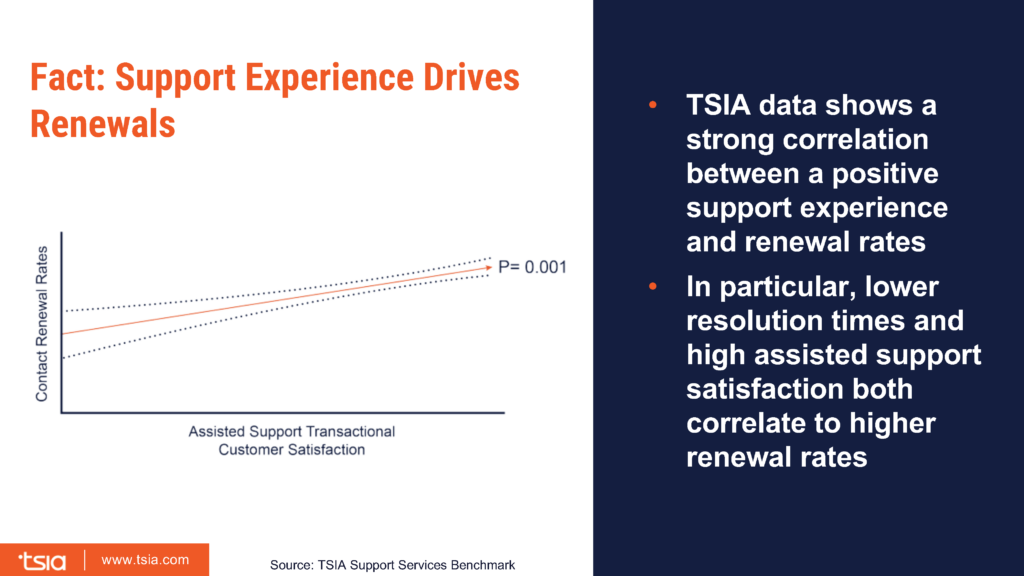
John: Why aren’t companies doing the math to show the impact of a good support experience within their own organizations? And what is a better way to calculate truly actionable health scores?
Judi: I love seeing this benchmark data, John. I’d say there’s a lot of reasons for companies not investing – it’s conflicting priorities, right? It’s the fact that there is so much data. And for a lot of individual organizations, this is a manual exercise that they go through. But, for instance, when I implemented SupportLogic as a customer at Mulesoft, I was able to do things in minutes that used to take days or weeks. I could look at my entire case history, in moments. We were able to go back to the other organizations and show where we had an opportunity to upsell customers.
The better way to calculate an actionable health score is to quantify the elements of the support experience where most of the interactions are happening and guide the clear actions to take to improve customer health.
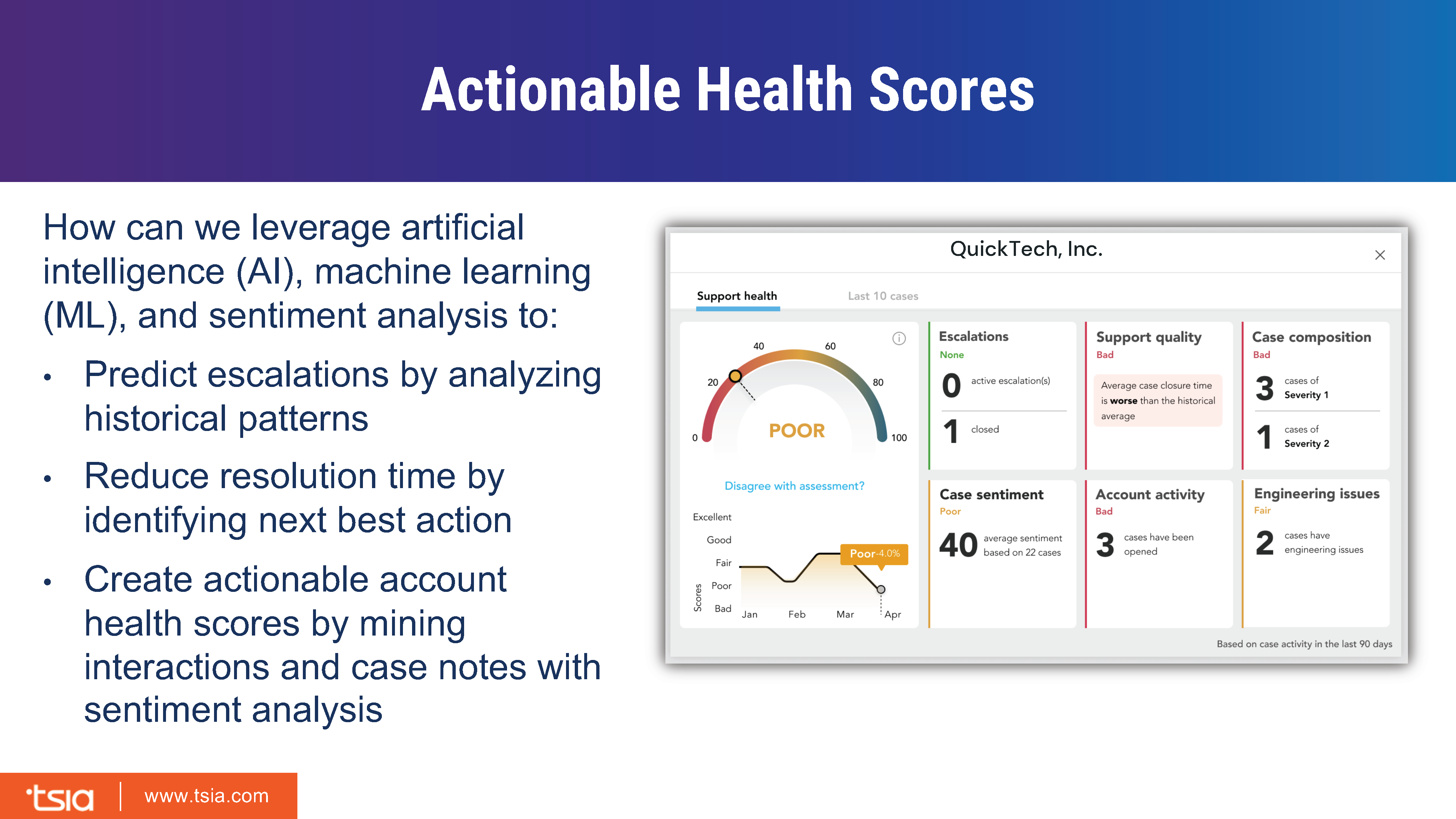
At SupportLogic, we’re delivering an actionable account health score based on the contextual insights within the support experience that provide an accurate indicator of your customer’s support health. There are six quantitative factors that power the score, including:
- Escalation volume and trend
- Customer sentiment trend and recency
- Support quality based on case resolution time trend
- Customer engagement based on new customer cases created trend
- Case composition based on case severity distribution
- Product quality and complexity based on signals within the cases
One thing I want all support people to take away today is, let’s stop thinking that escalations are just a part of life. Right? And I think a lot of organizations do just accept them. How about thinking that we don’t have to have any at all? And the other thing is expanding visibility to other functions – customer success, our engineering teammates and such. Putting relevant support information into the hands of other teams that are empowered to do good things for customers.
John: How does the rest of the organization benefit from investing in support experience?
Judi: Times are tough, but the tougher thing is keeping a customer happy. The customer journey and understanding how you measure yourself through that journey is imperative. Beyond the direct support team, many of the other functions directly benefit from the signals that are derived from the support experience:
Customer success managers are so critical in this customer journey, because where a CFO may be sitting now and looking at cutting some of the spend, it is going to fall back to these CSMs and their relationships in the company. Those relationships will affect whether or not some redlining happens to the renewal, etc. Successfully on-boarding new customers is most critical right now. The first seed of churn risk is planted then. There will be intense scrutiny for it to get better faster and it’s invaluable for them to see the trends that exist in the data.
For product and engineering, typically they see the defects and the enhancement requests. So we’d say what, maybe that’s 20 percent of the case volume; they don’t see the other 80 percent. And in that 80 percent is invaluable information that they could be using to make the product better, stop building features that customers don’t use, fix things that only support knows how to fix. In that case, what if the product team would just fix it permanently?
For executives and finance, understanding the levers to get to the net retention that we want for the revenue, being able to improve the margins, tools like this are absolutely invaluable. Customer health scoring is absolutely invaluable. CFOs today are getting involved in a lot more conversations about renewals of products, they’re looking at every single product, and do you need it?
For IT, people are fighting for priority and we all know historically sales wins and support gets deprioritized in the changes they need from IT. So again, health scoring and understanding and being able to say to somebody in IT, ‘if we did this, we’d improve our customer experience.’ And attaching a dollar amount, it’s invaluable. And so I think support again, as you look around this circle here, how could you not want to take that data and use it in meaningful ways?
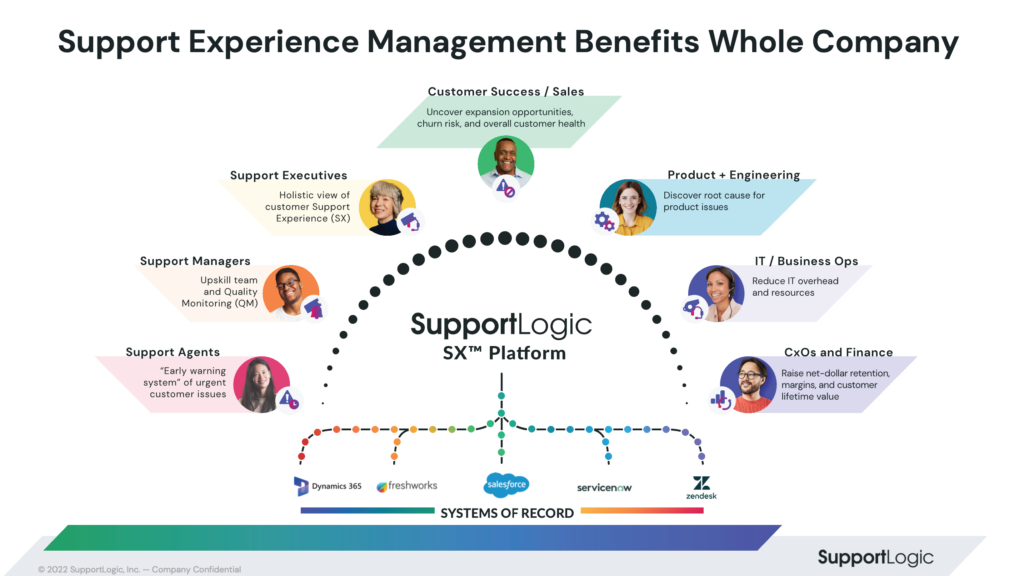
How to make the business case for support experience?
Join us for the next conversation on making the business case to invest in support experience. SupportLogic will host a webinar with Rebecca Wettemann from Valoir on January 18, 2023 – register here. We’ll discuss the main reasons companies are choosing to invest in support experience, based on Rebecca’s primary research. And we’ll share the four steps to building a business case and best practices to achieve credible, sustainable, and consistent results.
Don’t miss out
Want the latest B2B Support, AI and ML blogs delivered straight to your inbox?
